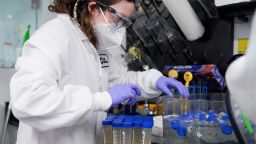Maybe BA.2 really is the “stealth variant.”
The Omicron subvariant caused as many as 3 in 4 cases of Covid-19 in the United States last week, according to the latest genomic surveillance from the US Centers for Disease Control and Prevention, but so far, there are no signs of a looming surge in the US.
Even as BA.2 has become dominant, overall numbers of cases are still decreasing, says Dr. Jessica Justman, an epidemiologist at Columbia University’s Mailman School of Public Health.
“This is a clear example of how these two trends are not necessarily tied together,” she says.
If things stay quiet, as some models predict, it will mark the first time a viral strain has taken over in the US without causing an increase in Covid-19 cases.
That’s different from what’s happening in the UK, some European countries and parts of Canada, where the arrival of BA.2 coincided with a new wave of cases and hospitalizations.
Andy Pekosz, who studies viruses at Johns Hopkins University, says the new wave of cases in Europe may have more to do with timing than any features of BA.2.
“What you’re seeing in Europe may be resulting from the fact that they lifted their restrictions early, not so much that it’s BA.2 that’s there,” he says.
Pekosz says many European countries dropped some precautions when there was already lot of virus circulating. He says cases in the US were coming down faster and fell farther before BA.2 outgrew its Omicron cousin here.
“When you start at a low place, it takes a lot longer to build up a high number of cases,” he says.
It also suggests that the US may not be entirely out of the woods with BA.2 since Spring Break and the Easter and Passover holidays will mean more travel and more mixing of people from different parts of the country.
Little sign of rising infections
Why the US isn’t seeing the same increases in new infections with BA.2 as countries in Europe did continues to be an open question.
One theory is that we’re no longer seeing positive cases show up in testing. The data collected by the CDC and state health departments about positive tests is generated by laboratories; it doesn’t count the tests people take at home.
And there’s been a “dramatic shift” toward at-home testing in the US, says Mara Aspinall, a professor at Arizona State University who has been estimating home and lab testing volumes.
In January and February, she says, there were roughly 1 million to 1.5 million Covid-19 laboratory tests being recorded each day – but 6 million to 8 million at-home tests available. A case detected by an at-home test doesn’t typically get reported unless it is later confirmed by a lab test.
“I think there’s no question there’s underreporting of positive cases,” Aspinall said. She believes this is, in part, why the CDC has shifted its pandemic measures to focus on hospitalizations and hospital capacity, and pivoted its surveillance to wastewater, which measures infection levels even when people aren’t getting tested.
Watching wastewater
Even in wastewater, though, there’s not a lot to see.
Zooming in on areas of the country that are seeing more BA.2 transmission, like New York, wastewater has been only modestly affected.
“It’s still low when we look at absolute raw numbers of viral copies in wastewater,” said David Larson, an associate professor of public health at Syracuse University who helped create the state’s wastewater dashboard.
“We’re not at the level of the Omicron [BA.1] surge, but it’s increasing, and community spread is present, and transmission is still high,” Larson said.
With more virus being transmitted, Larson says, officials could see cases go up, but he’s not sure. It will depend on how sick people get from their infections.
“Cases measure access to treatment and access to testing,” he said. “So it’s hard to say what cases will do.”
San Francisco is also seeing signs that BA.2 may be making a move, but it hasn’t been a major one.
Dr. Peter Chin-Hong, an infectious disease specialist at the University of California, San Francisco, says the Bay Area has been one of the most cautious parts of the country throughout the pandemic. There are even some schools that are still closed because they’re unwilling to tolerate the risk.
He was surprised to see San Francisco County recently take the top spot for its seven-day average of new cases on the California Department of Public Health’s Covid Dashboard.
“I had to rub my eyes,” Chin-Hong said. “I look at these trends pretty much every day, and SF used to be amongst the lowest, and now it’s amongst the highest” in terms of new cases. Test positivity is inching up, too.
But the increases he’s seeing are small ones. “They’re teetering on the point of going up and like trying to boost forward,” he said.
Chin-Hong says San Francisco is “super immune” right now, with one of the highest vaccination rates in the country and an antibody boost from recent wave of infections from Omicron’s BA.1 version.
At the hospital where he works, things are quiet in terms of Covid-19.
It reminds him of what happened in Denmark and South Africa with BA.2, “which was basically nothing. No explosions of cases, no lives lost.”
That won’t stop people from feeling anxious, he said. As cases rise, people will stay home and will keep their kids home from school.
He says the anxiety comes from two things: PTSD from previous surges and a measure of freedom that they don’t want to give up.
And though he’s not ready to sound the all-clear, he thinks things may be better than people are expecting this time around.
Are we failing upward?
If BA.2 does go quietly, it may be because the US did such a poor job of stopping transmission of Omicron and the variants that came before it, that we have failed upward, bungling our way to a high level of immune protection.
BA.1 and BA 1.1 ran rampant in the US over the winter, as people abandoned mask wearing and largely resumed their holiday plans.
“That spike was just massive. It was like nothing we’ve seen before,” says Mariana Matus, president and CEO of Biobot Analytics, a company that that’s been testing wastewater for local counties and other sewersheds across the US since 2020.
Matus says Omicron and Delta swept through the population in a matter of weeks, while BA.2 has been creeping up for a few months.
Get CNN Health's weekly newsletter
Sign up here to get The Results Are In with Dr. Sanjay Gupta every Tuesday from the CNN Health team.
“It’s been going very, very slowly, and so far, we haven’t seen an impact on the level of disease,” she said.
Matus points to Ontario, which is seeing a larger viral load in its wastewater levels, indicating more infections. That province’s Omicron peak with BA.1 a few months ago was not as high as the one in the US and may not have left as much immunity in its wake.
“That data, to me, would say that, you know, they had a smaller Omicron wave, and now [BA.2 is] picking up,” she said.
The latest CDC estimate is that 95% of Americans have some level of immunity, either through infection or from vaccination. About 43% of Americans are thought to have antibodies from infection.
This immunity came at a high price: The US remains a world leader in Covid-19 deaths with more than 980,000, according to data from Johns Hopkins University.
Remembering this makes any respite from Covid-19 over the next few weeks somewhat bittersweet. It may also be brief, as the world waits to see what other surprises the virus has in store.
Correction: This story has been updated to correct the spelling of Mariana Matus’ name.


















